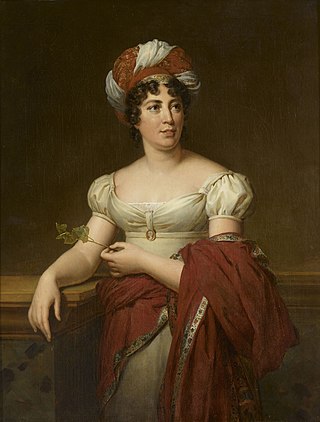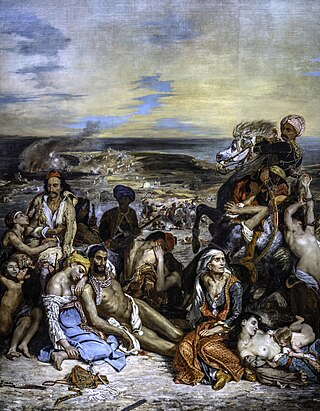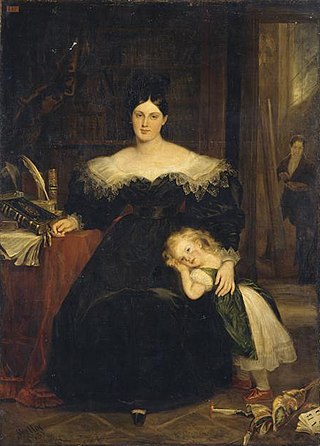Related Research Articles

Prosper Mérimée was a French writer in the movement of Romanticism, one of the pioneers of the novella, a short novel or long short story. He was also a noted archaeologist and historian, an important figure in the history of architectural preservation. He is best known for his novella Carmen, which became the basis of Bizet's opera Carmen. He learned Russian, a language for which he had great affection, before translating the work of several notable Russian writers, including Pushkin and Gogol, into French. From 1830 until 1860 he was the inspector of French historical monuments, responsible for the protection of many historic sites, including the medieval citadel of Carcassonne and the restoration of the façade of the cathedral of Notre-Dame de Paris. Along with the writer George Sand, he discovered the series of tapestries called The Lady and the Unicorn, arranging for their preservation. He was instrumental in the creation of Musée national du Moyen Âge in Paris, where the tapestries now are displayed. The official database of French monuments, the Base Mérimée, bears his name.
This article contains information about the literary events and publications of 1824.
This article contains information about the literary events and publications of 1816.
This article presents lists of the literary events and publications in 1815.

Anne Louise Germaine de Staël-Holstein, commonly known as Madame de Staël, was a prominent philosopher, woman of letters, and political theorist in both Parisian and Genevan intellectual circles. She was the daughter of banker and French finance minister Jacques Necker and Suzanne Curchod, a respected salon hostess. Throughout her life, she held a moderate stance during the tumultuous periods of the French Revolution and the Napoleonic era, persisting until the time of the French Restoration.

François Ponsard was a French dramatist, poet and author and was a member of the Académie française.

Philhellenism was an intellectual movement prominent mostly at the turn of the 19th century. It contributed to the sentiments that led Europeans such as Lord Byron, Charles Nicolas Fabvier and Richard Church to advocate for Greek independence from the Ottoman Empire.

Childe Harold's Pilgrimage: A Romaunt is a long narrative poem in four parts written by Lord Byron. The poem was published between 1812 and 1818. Dedicated to "Ianthe", it describes the travels and reflections of a young man disillusioned with a life of pleasure and revelry and looking for distraction in foreign lands. In a wider sense, it is an expression of the melancholy and disillusionment felt by a generation weary of the wars of the post-Revolutionary and Napoleonic eras. The title comes from the term childe, a medieval title for a young man who was a candidate for knighthood.

Antoine Fabre d'Olivet was a French author, poet and composer whose Biblical and philosophical hermeneutics influenced many occultists, such as Eliphas Lévi, Gérard Encausse ("Papus") and Édouard Schuré.

The Villa Diodati is a mansion in the village of Cologny near Lake Geneva in Switzerland, notable because Lord Byron rented it and stayed there with Dr. John Polidori in the summer of 1816. Mary Shelley, Percy Bysshe Shelley, and Mary’s stepsister Claire Clairmont, who had rented a house nearby, were frequent visitors. Because of poor weather, in June 1816 the group famously spent three days together inside the house creating stories to tell each other, two of which were developed into landmark works of the Gothic horror genre: Frankenstein by Mary Shelley and The Vampyre, the first modern vampire story, by Polidori.

Cain is a dramatic work by Lord Byron published in 1821. In Cain, Byron dramatizes the story of Cain and Abel from Cain's point of view. Cain is an example of the literary genre known as closet drama.
Nationality words link to articles with information on the nation's poetry or literature.
Nationality words link to articles with information on the nation's poetry or literature.
The Romantic hero is a literary archetype referring to a character that rejects established norms and conventions, has been rejected by society, and has themselves at the center of their own existence. The Romantic hero is often the protagonist in a literary work, and the primary focus is on the character's thoughts rather than their actions.

Étienne-Paulin Gagne, known as Paulin Gagne was a French poet, essayist, lawyer, politician, inventor, and eccentric. His best-known poem, The Woman-Messiah, is among the longest poems in French, or any language. The poem is 25,000 verses and is notable for its 24th act entitled Bestiologie which enumerates the advantages that a citizen of Paris would have by marrying the animals of the Jardin des Plantes. He is also notable for proposing anthropophagy (cannibalism) at a public meeting and offering himself as food to starving Algerians.

George Gordon Byron, 6th Baron Byron, was an English poet and peer. He is one of the major figures of the Romantic movement, and is regarded as being among the greatest of English poets. Among his best-known works are the lengthy narratives Don Juan and Childe Harold's Pilgrimage; many of his shorter lyrics in Hebrew Melodies also became popular.

Louise de Broglie, Countess d'Haussonville was a French essayist and biographer, and a member of the House of Broglie, a distinguished French family. A granddaughter of the novelist Germaine de Staël, she was considered independent, liberal, and outspoken. Her 1845 portrait by Jean-Auguste-Dominique Ingres, which took three years to complete, has been exhibited in the Frick Collection in New York City since the 1930s.

Louise Swanton Belloc, née Anne-Louise Chassériau Swanton, was a French writer and translator of Irish descent best known for introducing a number of important works of English literature to France. She is also remembered as a strong proponent of women's education, and was awarded a gold medal by the Institut in her twenties for her literary accomplishments. Marc-Antoine Jullien de Paris, the distinguished founder of the Revue encyclopédique, once referred to her as "a young person of brilliant talents".
Charles Derennes was a French novelist, essayist and poet, the winner of the Prix Femina in 1924.

The Coppet group, also known as the Coppet circle, was an informal intellectual and literary gathering centred on Germaine de Staël during the time period between the establishment of the Napoleonic First Empire (1804) and the Bourbon Restoration of 1814–1815. The name comes from Coppet Castle in Switzerland.
References
- ↑ Aux bureaux de la revue, ed. (1891). Polybiblion: Revue bibliographique universelle, Volume 62.
- ↑ Adolphus William Ward; Alfred Rayney Waller, eds. (1916). The Cambridge History of English Literature: The nineteenth century, 1-3. p. 435.